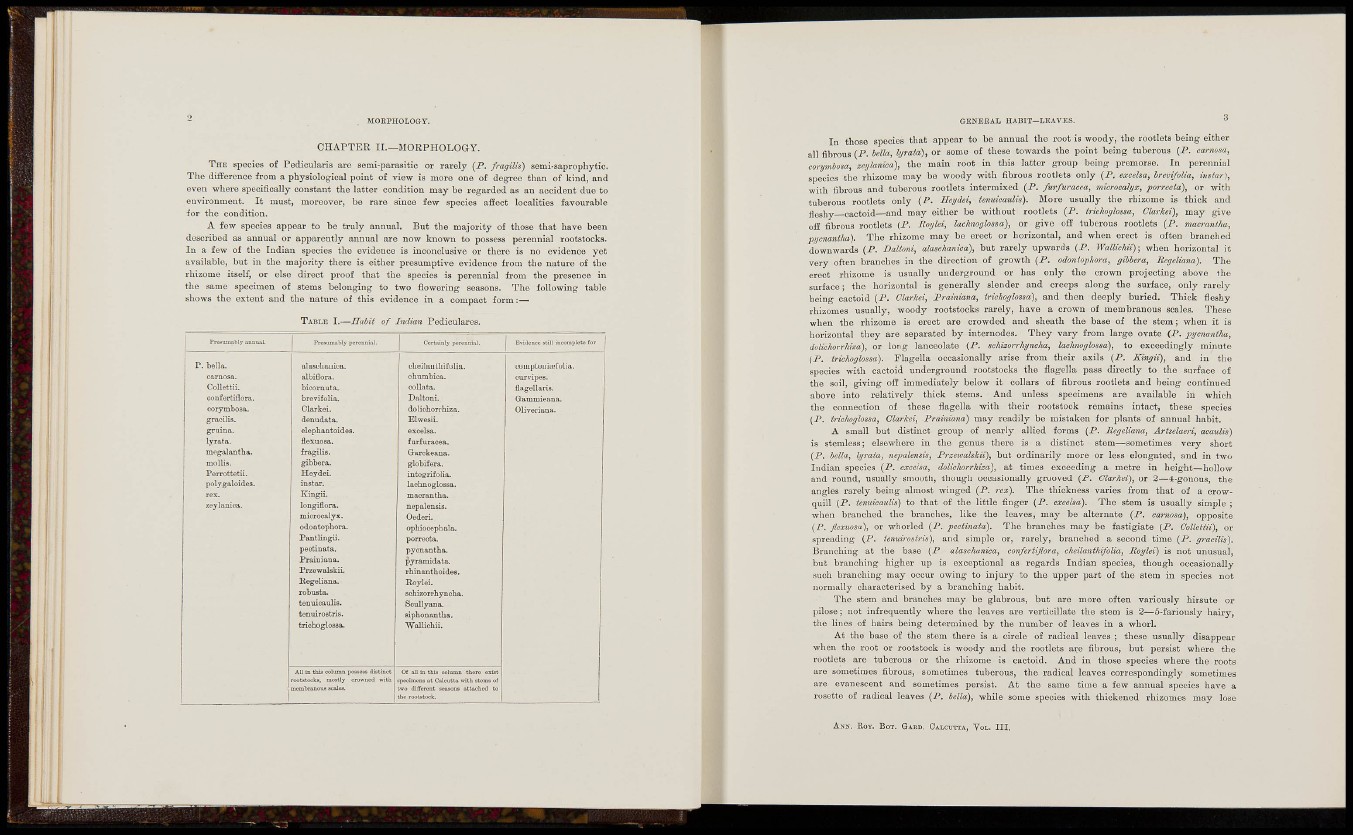
MOEPHOLOGY.
C H A P T E R II.—MORPHOLOGY.
THE species of Pedicularis are semi-parasitic or rarely (P. fragilis) semi-saprophytie.
The difference f rom a physiological point of view is more one of degree than of kind, and
even where specifically constant the latter condition may be regarded as an accident due to
environment. It must, moreover, be rare since few species affect localities favourable
f o r the condition.
A few species appear to be truly annual. But the majority of those that Iiave been
described as annual or apparently annual are now known to possess perennial rootstocks.
I n a few of the Indian species the evidence is inconclusive or there is no evidence yet
available, but in the majority there is either presumptive evidence from the nature of the
rhizome itself, or else dii-ect proof that the species is perennial from the presence in
t h e same specimen of stems belonging to two flowering seasons. The following table
shows the extent and the nature of this evidence in a compact form:—
TABLE I.—Habit of Indian Pediculaies.
Proaumably nnuual Presumably perennial. CortAinly perennial. Byidenoo still iiieoniplato for j
P. bella. alascbanica. obeilantbifolia. comptoniffifolia.
carEOsa. albiflora. ohumbica. curripés,
CoUettii. bicornuta. collata. flagellaris.
confertiflora, brevifolia. Daltoni. Gammieana.
corymb osa. Clarkei. doUchorrbiza. OHveriana.
gracilis. denudata. Elwesii.
grain a. elepbantoides. excelsa.
lyrata. fiexuosa. furfuracea.
• megalantha. fragilis. Garckeana.
mollis. gibbera. globifera.
Perrottetii. Heydei. integrifoiia.
poly gaio ides. instar. lachnoglossa.
res. Kingii. macrantba.
zeylaniea. loDgiflora. nepalensis.
microcalyx. Oederi.
odontopbora. opbiocephala.
Pantlingii. porrecta.
pectinata. pycnantba.
Prainiana. pyramid ata.
Przewalskii. rbinantboides.
Begdliana. Eoylei.
robusta. Bobizorrbyncba.
tenuicaulis. ScuUyana.
tenuirostris. siphonantba.
trichoglossa. Wallicbii.
All in this column possass distinct Of aU in this column there ejist
rootstocks, mostly orowncd witb spocimons at Calcutta with stems of
membruous scales. two different seasons attached to 1 tho rootstock.
GENERAL HABIT-LEAVES.
In those species that appear to be annual the root is woody, the rootlets being either
all fibrous (P. hella, lyratd), or some of these towards the point being tuberous {P. carnosa,
corumhosa, zcylanica), the main root in this latter group being premorse. In perennial
species the rhizome may be woody with fibrous rootlets only (P. exeelsa, brevifolia, i7istar),
with fibrous and tuberous rootlets intermixed (P. furfuracea, microcalyx, porrecia), or with
tuberous rootlets only (P. Heydei, tenuicaulis). More usually the rhizome is thick and
j^gshy cactoid and may either be without rootlets (P. trichoglossa, Clarkei), may give
off fibrous rootlets (P. RoyUi, lachnoglossa), or give off tuberous rootlets (P. macrantha,
pycnantha). The rhizome may be erect or horizontal, and when erect is often branched
downwards (P. Daltoni, alasehanioa), but rarely upwards (P. Wallichii)-, when horizontal it
very often branches in the direction of growth (P. odoniophora, gibhcra, Regeliana). The
erect rhizome is usually underground or has only the crown projecting above the
surface; the horizontal is generally slender and creeps along the surface, only rarely
being cactoid (P. ClarJcei, Frainiana, iriehoglossa), and then deeply buried. Thick fleshy
rhizomes usually, woody rootstocks rarely, have a crown of membranous scales. These
when the rhizome is erect are crowded and sheath the base of the stem; when it is
horizontal they are separated by internodes. They vary from large ovate (P. pycnantha,
doliehorrhiza), or long lanceolate (P. schizorrhyncha, lachnoglossa), to exceedingly minute
( P . triehoglossa). Flagella occasionally arise from their axils (P. Kingii), and in the
species with cactoid underground rootstocks the flagella pass directly to the surface of
t h e soil, giving off immediately below it collars of fibrous rootlets and being continued
above into relatively thick stems. And unless specimens are available in which
t h e connection of these flagella with their rootstock remains intact, these species
( P . tiichoglossa, Clarkei, Prainiana) may readily be mistaken for plants of annual habit.
A small but distinct group of nearly allied forms (P. Regeliana, Artselaeri, aeaulis)
is stemless; elsewhere in the genus there is a distinct stem—sometimes very short
( P . bella, lyrata, ne2)alensis, Przezvalskii), but ordinarily more or less elongated, and in two
Indian species (P. ezcelsa, doUchorrkisa), at times exceeding a metre in height—hollow
and round, usually smooth, though occasionally grooved (P. Clarkei), or 2—4-gouous, the
angles rarely being almost winged (P. rex). The thickness varies from that of a crowquill
(P. tenuioaulis) to that of the little finger (P. ezcelsa). The stem is usually simple ;
when branched the branches, like the leaves, may be alternate (P. cai'nosa), opposite
( P . flexuosa), or whorled (P. pectinata). The branches may be fastigiate (P. CoUettii), or
spreading (P. tenuiro&tris), and simple or, rarely, branched a second time (P. gracilis).
Branching at the base (P alasclianiea, confertiflora, cheilanthifolia, Roy lei) is not unusual,
but branching higher up is exceptional as regards Indian species, though occasionally
such branching may occur owing to injmy to tiie upper part of the stem in species not
normally characterised by a branching habit.
The stem and branches may be glabrous, but are more often variously hirsute or
pilose; not infrequently where the leaves are verticillate the stem is 2—5-fariously hairy,
t h e lines of hairs being determined by the number of leaves in a whorl.
At the base of the stem there is a circle of radical leaves ; these usually disappear
when the root or rootstock is woody and the rootlets are fibrous, but persist where the
rootlets are tuberous or the rhizome is cactoid. And in those species where the roots
are sometimes fibrous, sometimes tuberous, the radical leaves correspondingly sometimes
are evanescent and sometimes persist. At the same time a few annual species have a
rosette of radical leaves (P. bella), while some species with thickened rhizomes may lose
Asîf, KOY. BOT. GARD, CALCUTTA, YOL. III.